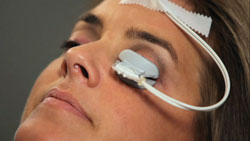Novel treatment available for meibomian gland dysfunction
Click Here to Manage Email Alerts
TearScience is in the early stages of initiating widespread commercial availability of its new thermal pulsation system, which may be indicated in the majority of dry eye patients.
“At least 70% of patients with dry eye symptoms have some degree of meibomian gland disease,” Primary Care Optometry News Editorial Board member John A. Hovanesian, MD, FACS, said in an interview.
TearScience’s LipiFlow was recently cleared by the US Food and Drug Administration for treating meibomian gland dysfunction.
 This patient with meibomian gland dysfunction is being treated with the TearScience LipiFlow system. Image: TearScience |
“Unlike warm compresses, which patients are often noncompliant with, clinical data has shown that a single treatment with LipiFlow provides meaningful relief, on average, through the final study visit at 1 month,” Dr. Hovanesian said.
Additional studies are planned to evaluate patients over a longer follow-up duration.
This straightforward procedure is performed in-office under local anesthetic, lasts about 12 minutes and “is well tolerated by most patients,” Dr. Hovanesian said.
TearScience’s system consists of two devices. The LipiFlow Ocular Surface Interferometer captures detailed digital images of the tear film to allow clinicians to assess it.
The second device, called LipiFlow, consists of a console with a disposable eye piece that is placed around the patient’s eyelids. Essentially, the device applies heat to the patient’s eyelids to liquefy meibomian gland obstructions and employs a gentle programmed pulsatile pressure that is designed to express the meibomian glands, Dr. Hovanesian said.
“Early data suggest that the LipiFlow devices will add an important component to our treatment regimen for one of the most common conditions our patients face — evaporative dry eye,” Dr. Hovanesian said.
The primary criteria that make a patient a good candidate for the LipiFlow treatment are the presence of meibomian gland disease and dry eye symptoms, Dr. Hovanesian said.
Patients will, for now, pay out-of-pocket for the procedure, as it is currently not covered by Medicare and most commercial carriers, Dr. Hovanesian added. – by Daniel R. Morgan

- John A. Hovanesian, MD, FACS, is a member of the Primary Care Optometry News Editorial Board. He can be reached at Harvard Eye Associates, 24401 Calle De La Louisa, Suite 300, Laguna Hills, CA 92653; (949) 951-2020; fax: (949) 380-7856; drhovanesian@harvardeye.com.
- Disclosure: Dr. Hovanesian is a medical advisor to TearScience.
